Fractal Characteristics and Pore Structures of Shales from the Doushantuo Formation, Yichang Area, South China
Abstract
1. Introduction
2. Geologic Setting
3. Samples and Methods
3.1. Samples
3.2. Methods
3.3. Fractal Theory
4. Results
4.1. Mineral Content
4.2. Pore Network Characteristics
4.3. Fractal Characteristics
5. Discussion
5.1. Correlations Between Df and TOC
5.2. Correlations Between Df and Pore Structure Parameters
5.3. Correlations Between Df and Mineral Content
6. Conclusions
Author Contributions
Funding
Data Availability Statement
Conflicts of Interest
References
- McMahon, T.P.; Larson, T.E.; Zhang, T.; Shuster, M. Geologic characteristics, exploration and production progress of shale oil and gas in the United States: An overview. Pet. Explor. Dev. 2024, 51, 925–948. [Google Scholar] [CrossRef]
- Stretesky, P.; Grimmer, P. Shale gas development and crime: A review of the literature. Extr. Ind. Soc. 2020, 7, 1147–1157. [Google Scholar] [CrossRef]
- Cao, T.; Song, Z.; Wang, S.; Xia, J. Characterization of pore structure and fractal dimension of Paleozoic shales from the northeastern Sichuan Basin, China. J. Nat. Gas Sci. Eng. 2016, 35, 882–895. [Google Scholar] [CrossRef]
- He, H.; Liu, P.; Xu, L.; Hao, S.; Qiu, X.; Shan, C.; Zhou, Y. Pore structure representations based on nitrogen adsorption experiments and an FHH fractal model: Case study of the block Z shales in the Ordos Basin, China. J. Pet. Sci. Eng. 2021, 203, 108661. [Google Scholar] [CrossRef]
- Clarkson, C.R.; Solano, N.; Bustin, R.M.; Bustin, A.; Chalmers, G.; He, L.; Melnichenko, Y.; Radliński, A.; Blach, T. Pore structure characterization of North American shale gas reservoirs using USANS/SANS, gas adsorption, and mercury intrusion. Fuel 2013, 103, 606–616. [Google Scholar] [CrossRef]
- Al-Yaseri, A.Z.; Lebedev, M.; Vogt, S.J.; Johns, M.L.; Barifcani, A.; Iglauer, S. Pore-scale analysis of formation damage in Bentheimer sandstone with in-situ NMR and micro-computed tomography experiments. J. Pet. Sci. Eng. 2015, 129, 48–57. [Google Scholar] [CrossRef]
- Yang, R.; Hu, Q.; Yi, J.; Zhang, B.; He, S.; Guo, X.; Hou, Y.; Dong, T. The effects of mineral composition, TOC content and pore structure on spontaneous imbibition in Lower Jurassic Dongyuemiao shale reservoirs. Mar. Pet. Geol. 2019, 109, 268–278. [Google Scholar] [CrossRef]
- Meng, F.; Gan, H.; Zhang, Q.; Liu, X.; Li, Y. The Fractal Characteristics of Pore Networks in Tight Sandstones: A Case Study of Nanpu Sag in Bohai Bay Basin, NE China. Fractal Fract. 2025, 9, 560. [Google Scholar] [CrossRef]
- Siddiqui, M.A.Q.; Ueda, K.; Komatsu, H.; Shimamoto, T.; Roshan, H. Caveats of using fractal analysis for clay rich pore systems. J. Pet. Sci. Eng. 2020, 195, 107622. [Google Scholar] [CrossRef]
- Jiang, G.; Shi, X.; Zhang, S.; Wang, Y.; Xiao, S. Stratigraphy and paleogeography of the Ediacaran Doushantuo Formation (ca. 635–551 Ma) in south China. Gondwana Res. 2011, 19, 831–849. [Google Scholar] [CrossRef]
- Zhang, F.; Xiao, S.; Kendall, B.; Romaniello, S.J.; Cui, H.; Meyer, M.; Gilleaudeau, G.J.; Kaufman, A.J.; Anbar, A.D. Extensive marine anoxia during the terminal Ediacaran Period. Sci. Adv. 2018, 4, eaan8983. [Google Scholar] [CrossRef] [PubMed]
- Cui, H.; Xiao, S.; Zhou, C.; Peng, Y.; Kaufman, A.J.; Plummer, R.E. Phosphogenesis associated with the Shuram Excursion: Petrographic and geochemical observations from the Ediacaran Doushantuo Formation of South China. Sediment. Geol. 2016, 341, 134–146. [Google Scholar] [CrossRef]
- Yang, F.; Ge, Z.; Zheng, J.; Tian, Z. Viscoelastic surfactant fracturing fluid for underground hydraulic fracturing in soft coal seams. J. Pet. Sci. Eng. 2018, 169, 646–653. [Google Scholar] [CrossRef]
- Zhang, Z.; Yang, Z. Theoretical and practical discussion of measurement accuracy for physisorption with micro-and mesoporous materials. Chin. J. Catal. 2013, 34, 1797–1810. [Google Scholar] [CrossRef]
- Mandelbrot, B.B. Les Objets Fractals: Forme, Hazard et Dimension; Flammarion: Paris, France, 1975. [Google Scholar]
- Pfeifer, P.; Wu, Y.J.; Cole, M.W.; Krim, J. Multilayer adsorption on a fractally rough surface. Phys. Rev. Lett. 1989, 62, 1997. [Google Scholar] [CrossRef]
- Zhang, S.; Tang, S.; Tang, D.; Huang, W.; Pan, Z. Determining fractal dimensions of coal pores by FHH model: Problems and effects. J. Nat. Gas Sci. Eng. 2014, 21, 929–939. [Google Scholar] [CrossRef]
- Lai, J.; Wang, G.; Wang, Z.; Chen, J.; Pang, X.; Wang, S.; Zhou, Z.; He, Z.; Qin, Z.; Fan, X. A review on pore structure characterization in tight sandstones. Earth-Sci. Rev. 2018, 177, 436–457. [Google Scholar] [CrossRef]
- Liu, X.; Xiong, J.; Liang, L. Investigation of pore structure and fractal characteristics of organic-rich Yanchang formation shale in central China by nitrogen adsorption/desorption analysis. J. Nat. Gas. Sci. Eng. 2015, 22, 62–72. [Google Scholar] [CrossRef]
- Huang, L.; Xiao, Y.; Yang, Q.; Chen, Q.; Zhang, Y.; Xu, Z.; Feng, X.; Tian, B.; Wang, L.; Liu, Y. Gas sorption in shale media by molecular simulation: Advances, challenges and perspectives. Chem. Eng. J. 2024, 487, 150742. [Google Scholar] [CrossRef]
- Milliken, K.L.; Olson, T. Silica diagenesis, porosity evolution, and mechanical behavior in siliceous mudstones, Mowry Shale (Cretaceous), Rocky Mountains, USA. J. Sediment. Res. 2017, 87, 366–387. [Google Scholar] [CrossRef]
- Cao, Y.; Jin, Z.; Zhu, R.; Liu, K. Pore systems and their correlation with oil enrichment in various lithofacies of saline lacustrine shale strata. Int. J. Coal Geol. 2024, 282, 104444. [Google Scholar] [CrossRef]
- Wang, X.; Hou, J.; Li, S.; Dou, L.; Song, S.; Kang, Q.; Wang, D. Insight into the nanoscale pore structure of organic-rich shales in the Bakken Formation, USA. J. Pet. Sci. Eng. 2020, 191, 107182. [Google Scholar] [CrossRef]
- Du, X.; Song, X.; Zhang, M.; Lu, Y.; Lu, Y.; Chen, P.; Liu, Z.; Yang, S. Shale gas potential of the Lower Permian Gufeng Formation in the western area of the Lower Yangtze Platform, China. Mar. Pet. Geol. 2015, 67, 526–543. [Google Scholar] [CrossRef]
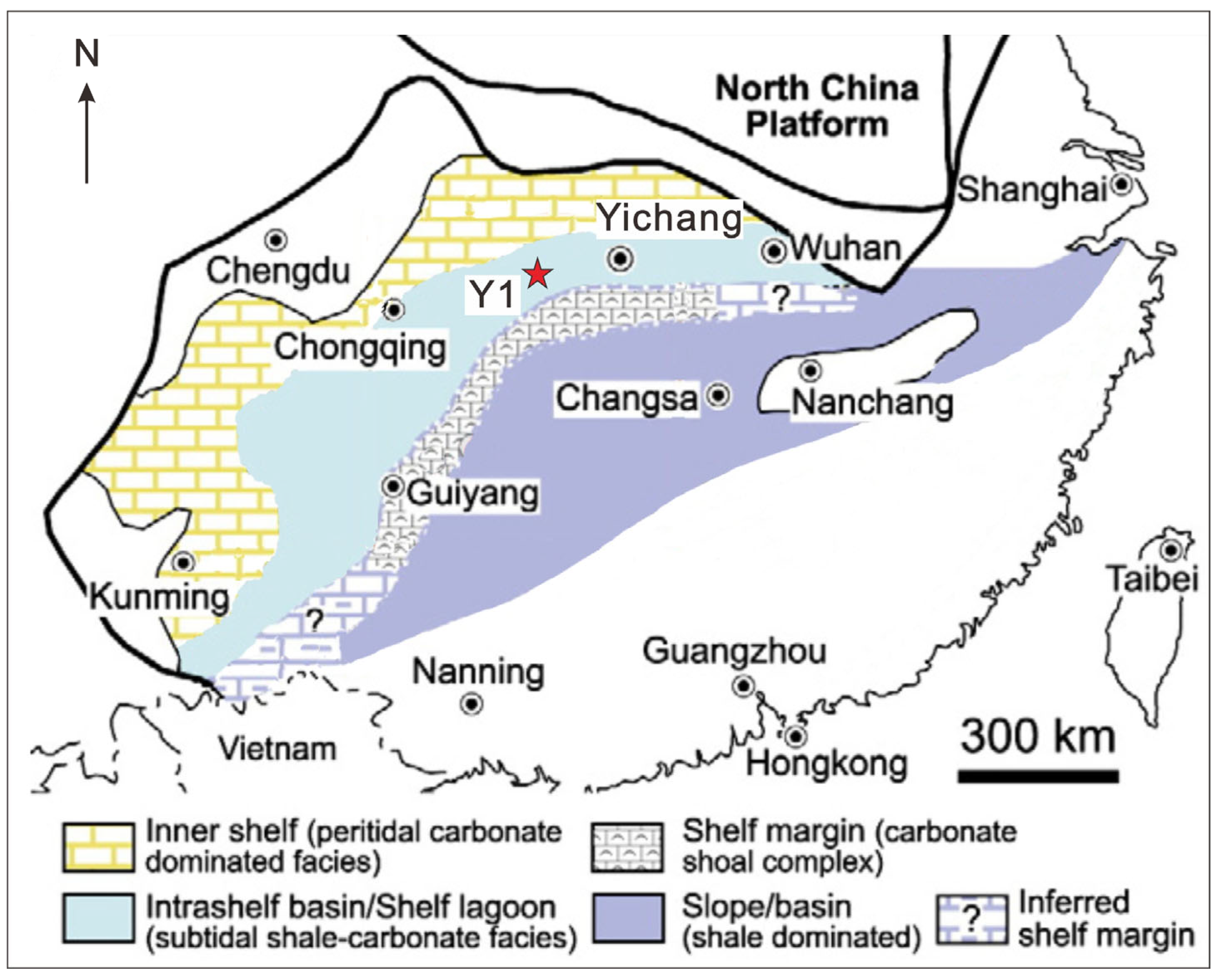

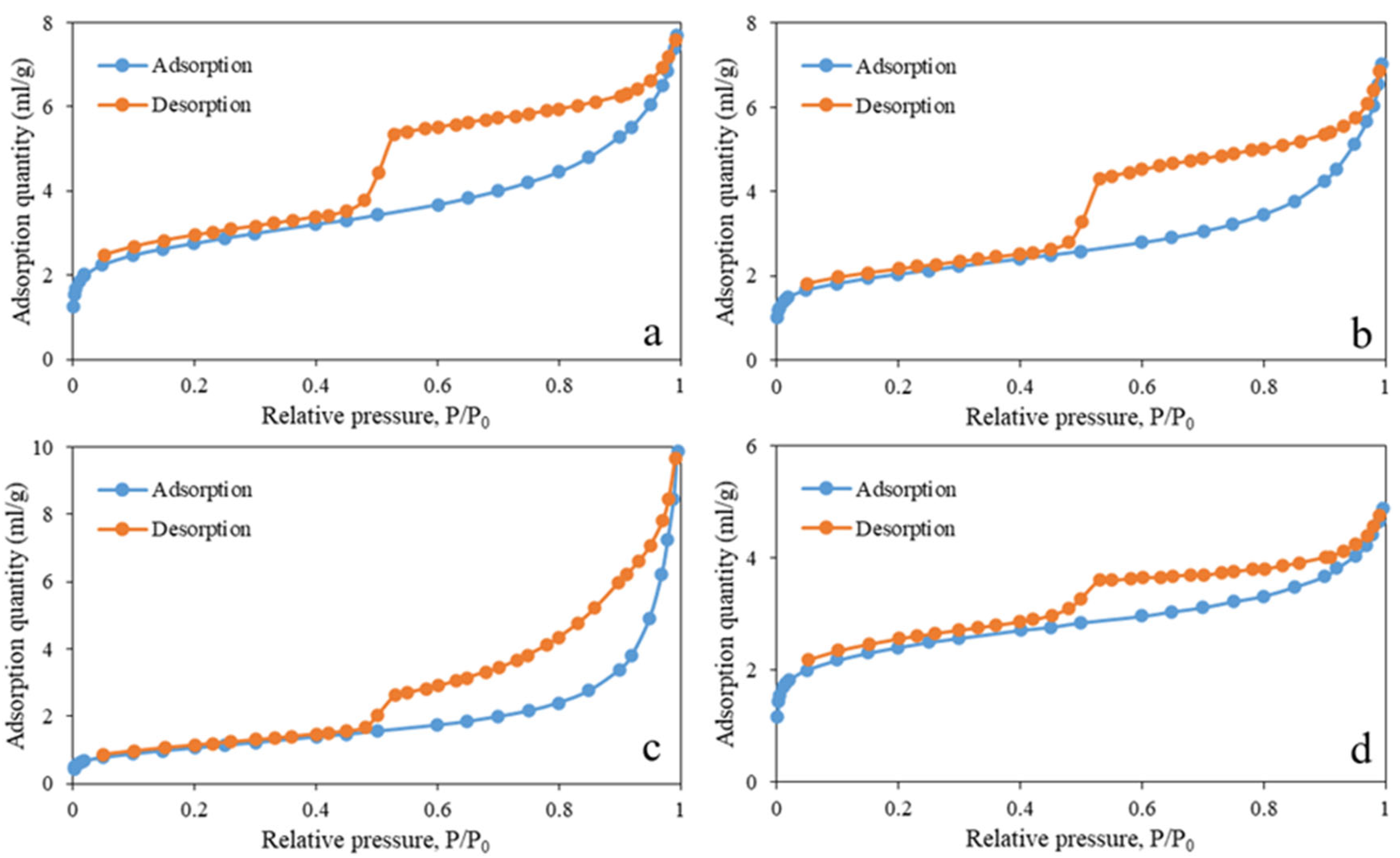
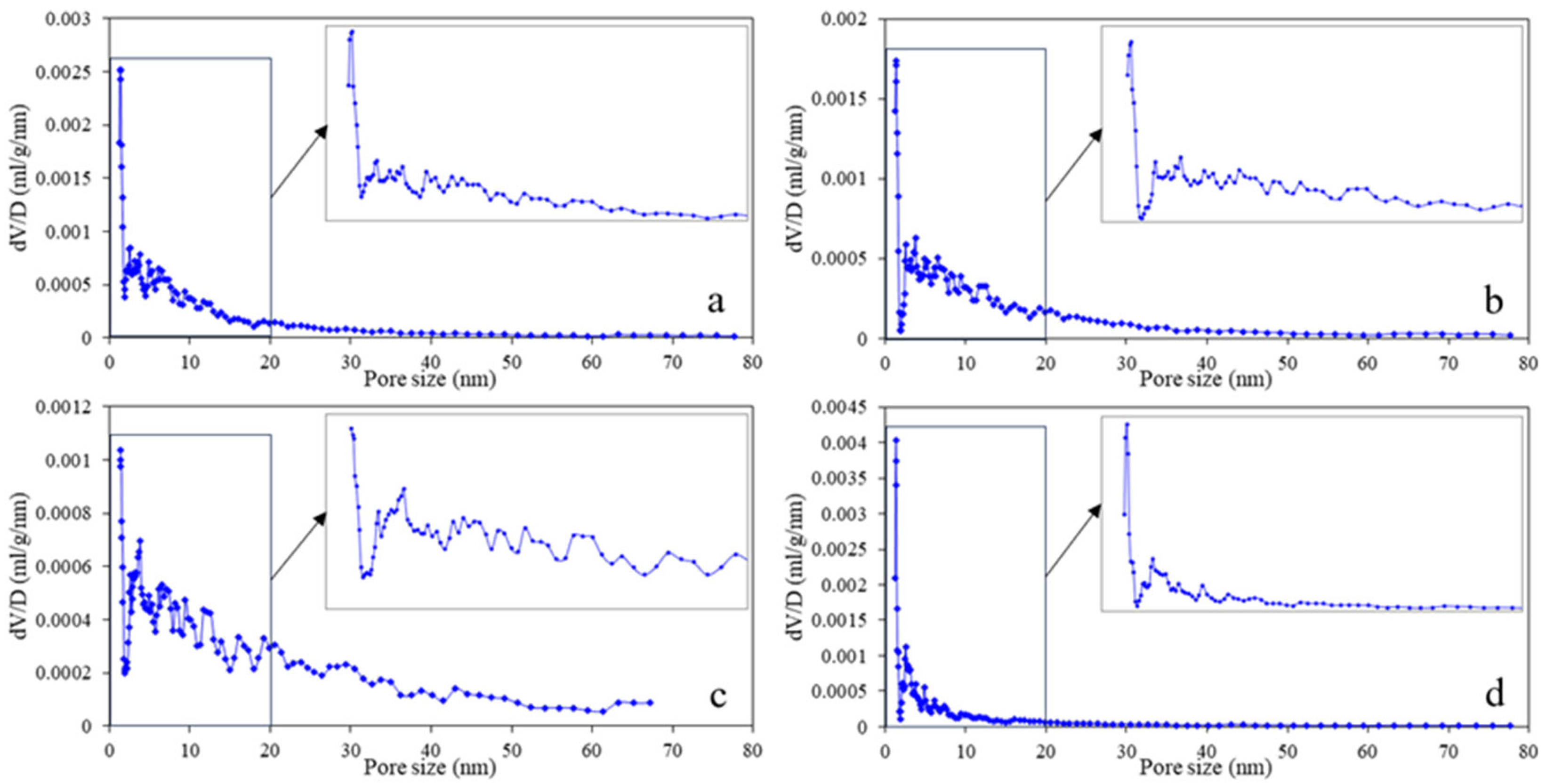



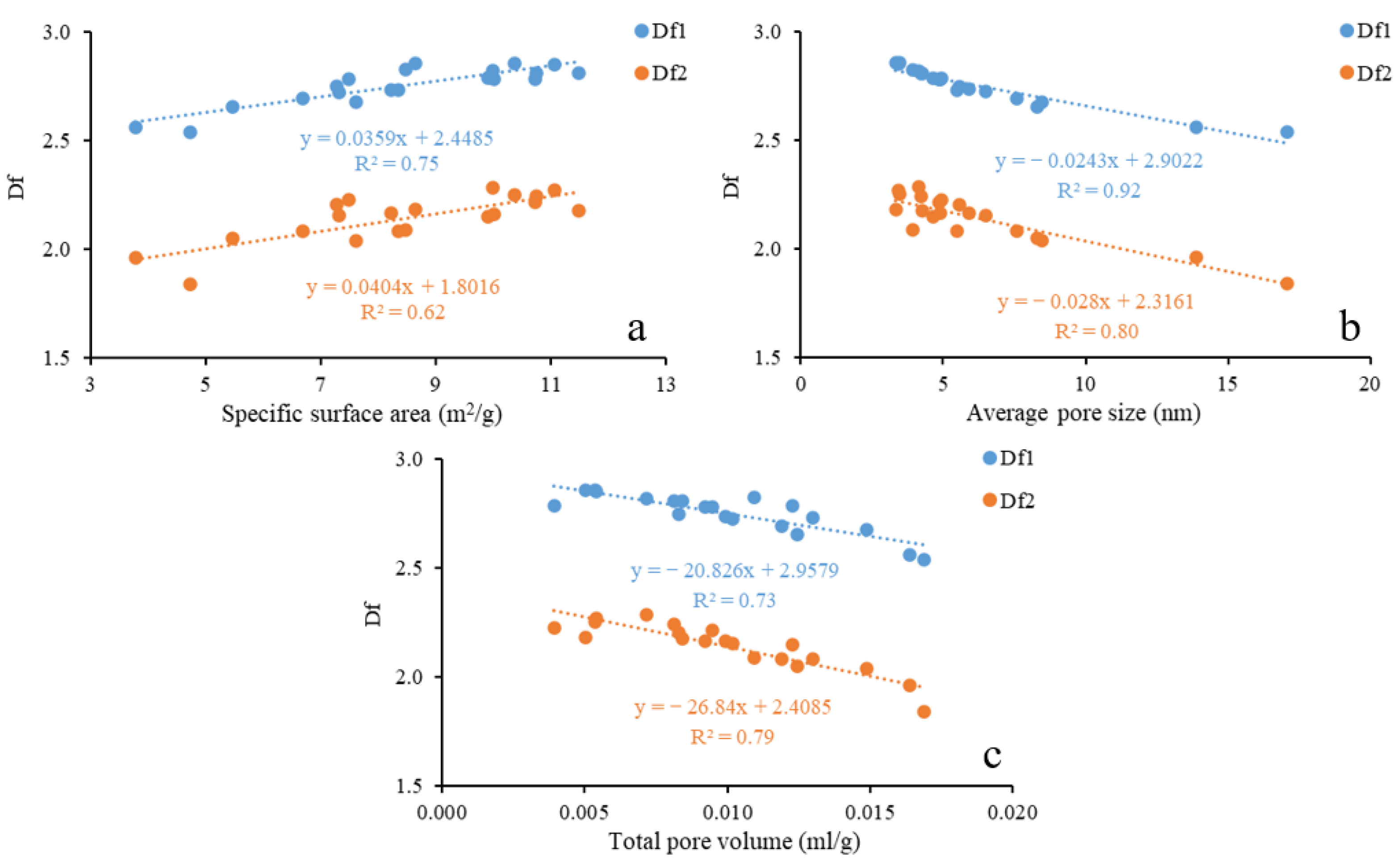
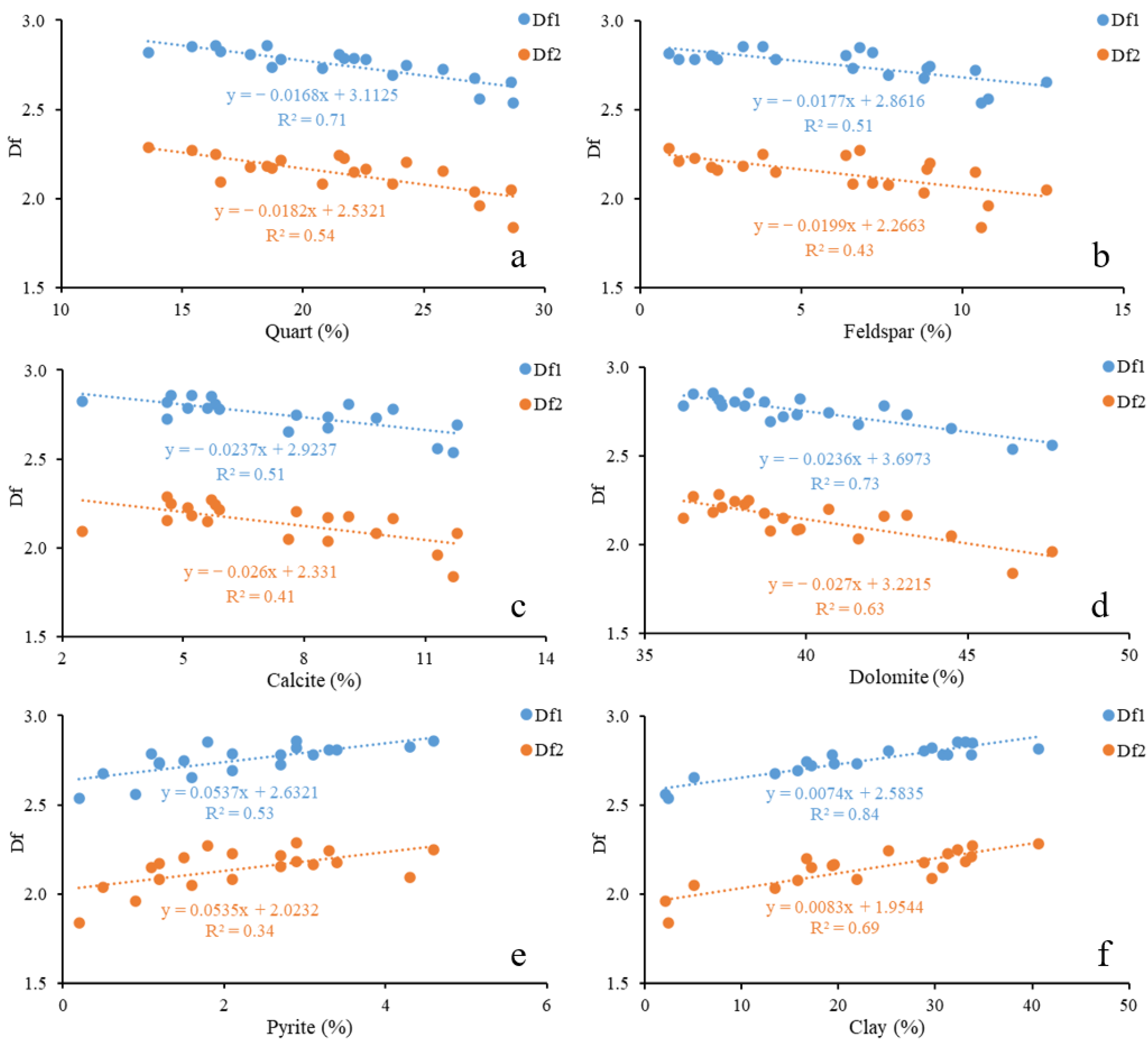
| Sample No. | Quartz (%) | Feldspar (%) | Calcite (%) | Dolomite (%) | Pyrite (%) | Clay (%) |
|---|---|---|---|---|---|---|
| 1 | 28.6 | 12.6 | 7.6 | 44.5 | 1.6 | 5.1 |
| 2 | 21.5 | 6.4 | 5.8 | 37.8 | 3.3 | 25.2 |
| 3 | 22.1 | 4.2 | 5.6 | 36.2 | 1.1 | 30.8 |
| 4 | 15.4 | 6.8 | 5.7 | 36.5 | 1.8 | 33.8 |
| 5 | 20.8 | 6.6 | 9.8 | 39.7 | 1.2 | 21.9 |
| 6 | 18.7 | 8.9 | 8.6 | 43.1 | 1.2 | 19.5 |
| 7 | 24.3 | 9 | 7.8 | 40.7 | 1.5 | 16.7 |
| 8 | 17.8 | 2.2 | 9.1 | 38.7 | 3.4 | 28.8 |
| 9 | 16.6 | 7.2 | 2.5 | 39.8 | 4.3 | 29.6 |
| 10 | 22.6 | 2.4 | 10.2 | 42.4 | 3.1 | 19.3 |
| 11 | 23.7 | 7.7 | 11.8 | 38.9 | 2.1 | 15.8 |
| 12 | 13.6 | 0.9 | 4.6 | 37.3 | 2.9 | 40.7 |
| 13 | 27.1 | 8.8 | 8.6 | 41.6 | 0.5 | 13.4 |
| 14 | 27.3 | 10.8 | 11.3 | 47.6 | 0.9 | 2.1 |
| 15 | 25.8 | 10.4 | 4.6 | 39.3 | 2.7 | 17.2 |
| 16 | 19.1 | 1.2 | 5.9 | 37.4 | 2.7 | 33.7 |
| 17 | 21.7 | 1.7 | 5.1 | 38.1 | 2.1 | 31.3 |
| 18 | 28.7 | 10.6 | 11.7 | 46.4 | 0.2 | 2.4 |
| 19 | 18.5 | 3.2 | 5.2 | 37.1 | 2.9 | 33.1 |
| 20 | 16.4 | 3.8 | 4.7 | 38.2 | 4.6 | 32.3 |
| Sample No. | Specific Surface Area (m2/g) | Total Pore Volume (mL/g) | Average Pore Size (nm) | Micropore Volume (mL/g) | Mesopore Volume (mL/g) | Macropore Volume (mL/g) |
|---|---|---|---|---|---|---|
| 1 | 5.474 | 0.01244 | 8.299 | 0.0001 | 0.0095 | 0.0010 |
| 2 | 10.75 | 0.008129 | 4.21 | 0.0022 | 0.0079 | 0.0006 |
| 3 | 9.899 | 0.012272 | 4.631 | 0.0018 | 0.0082 | 0.0007 |
| 4 | 11.05 | 0.005394 | 3.414 | 0.0024 | 0.0060 | 0.0004 |
| 5 | 8.356 | 0.012969 | 5.506 | 0.0013 | 0.0089 | 0.0006 |
| 6 | 8.214 | 0.009931 | 5.917 | 0.0014 | 0.0092 | 0.0008 |
| 7 | 7.282 | 0.008315 | 5.573 | 0.0013 | 0.0075 | 0.0007 |
| 8 | 11.49 | 0.008431 | 4.263 | 0.0023 | 0.0084 | 0.0007 |
| 9 | 8.47 | 0.01093 | 3.944 | 0.0045 | 0.0124 | 0.0012 |
| 10 | 9.999 | 0.009211 | 4.881 | 0.0018 | 0.0088 | 0.0008 |
| 11 | 6.685 | 0.0119 | 7.586 | 0.0009 | 0.0094 | 0.0012 |
| 12 | 9.996 | 0.007151 | 4.134 | 0.0021 | 0.0066 | 0.0008 |
| 13 | 7.602 | 0.01488 | 8.48 | 0.0010 | 0.0115 | 0.0021 |
| 14 | 3.78 | 0.01636 | 13.89 | 0.0001 | 0.0101 | 0.0018 |
| 15 | 7.317 | 0.01017 | 6.485 | 0.0010 | 0.0087 | 0.0009 |
| 16 | 10.73 | 0.009479 | 4.868 | 0.0021 | 0.0090 | 0.0009 |
| 17 | 7.481 | 0.003932 | 4.947 | 0.0007 | 0.0033 | 0.0005 |
| 18 | 4.72 | 0.016873 | 17.09 | 0.0001 | 0.0021 | 0.0006 |
| 19 | 8.651 | 0.00504 | 3.338 | 0.0020 | 0.0045 | 0.0003 |
| 20 | 10.37 | 0.005365 | 3.476 | 0.0022 | 0.0055 | 0.0006 |
| Sample No. | K1 | Df1 | Df1 Correlation Coefficient | K2 | Df2 | Df2 Correlation Coefficient |
|---|---|---|---|---|---|---|
| 1 | −0.3 | 2.7 | 0.98 | −1.0 | 2.0 | 0.93 |
| 2 | −0.2 | 2.8 | 0.98 | −0.8 | 2.2 | 0.95 |
| 3 | −0.2 | 2.8 | 0.98 | −0.8 | 2.2 | 0.94 |
| 4 | −0.1 | 2.9 | 0.96 | −0.7 | 2.3 | 0.96 |
| 5 | −0.3 | 2.7 | 0.99 | −0.9 | 2.1 | 0.95 |
| 6 | −0.3 | 2.7 | 0.99 | −0.8 | 2.2 | 0.96 |
| 7 | −0.3 | 2.7 | 0.99 | −0.8 | 2.2 | 0.96 |
| 8 | −0.2 | 2.8 | 0.98 | −0.8 | 2.2 | 0.94 |
| 9 | −0.2 | 2.8 | 0.98 | −0.9 | 2.1 | 0.96 |
| 10 | −0.2 | 2.8 | 0.99 | −0.8 | 2.2 | 0.95 |
| 11 | −0.3 | 2.7 | 0.99 | −0.9 | 2.1 | 0.98 |
| 12 | −0.2 | 2.8 | 0.98 | −0.7 | 2.3 | 0.96 |
| 13 | −0.3 | 2.7 | 0.99 | −1.0 | 2.0 | 0.98 |
| 14 | −0.4 | 2.6 | 0.99 | −1.0 | 2.0 | 0.98 |
| 15 | −0.3 | 2.7 | 0.98 | −0.8 | 2.2 | 0.98 |
| 16 | −0.2 | 2.8 | 0.99 | −0.8 | 2.2 | 0.97 |
| 17 | −0.2 | 2.8 | 0.99 | −0.8 | 2.2 | 0.9 |
| 18 | −0.5 | 2.5 | 0.99 | −1.0 | 2.0 | 0.97 |
| 19 | −0.1 | 2.9 | 0.97 | −0.8 | 2.2 | 0.93 |
| 20 | −0.1 | 2.9 | 0.96 | −0.7 | 2.3 | 0.9 |
Disclaimer/Publisher’s Note: The statements, opinions and data contained in all publications are solely those of the individual author(s) and contributor(s) and not of MDPI and/or the editor(s). MDPI and/or the editor(s) disclaim responsibility for any injury to people or property resulting from any ideas, methods, instructions or products referred to in the content. |
© 2025 by the authors. Licensee MDPI, Basel, Switzerland. This article is an open access article distributed under the terms and conditions of the Creative Commons Attribution (CC BY) license (https://creativecommons.org/licenses/by/4.0/).
Share and Cite
Meng, F.; Zhang, Q.; Wu, T.; Song, E.; Li, Y.; Sun, Y.; Liu, X. Fractal Characteristics and Pore Structures of Shales from the Doushantuo Formation, Yichang Area, South China. Fractal Fract. 2025, 9, 774. https://doi.org/10.3390/fractalfract9120774
Meng F, Zhang Q, Wu T, Song E, Li Y, Sun Y, Liu X. Fractal Characteristics and Pore Structures of Shales from the Doushantuo Formation, Yichang Area, South China. Fractal and Fractional. 2025; 9(12):774. https://doi.org/10.3390/fractalfract9120774
Chicago/Turabian StyleMeng, Fulin, Qiyang Zhang, Taifei Wu, Eping Song, Yan Li, Yi Sun, and Xiufan Liu. 2025. "Fractal Characteristics and Pore Structures of Shales from the Doushantuo Formation, Yichang Area, South China" Fractal and Fractional 9, no. 12: 774. https://doi.org/10.3390/fractalfract9120774
APA StyleMeng, F., Zhang, Q., Wu, T., Song, E., Li, Y., Sun, Y., & Liu, X. (2025). Fractal Characteristics and Pore Structures of Shales from the Doushantuo Formation, Yichang Area, South China. Fractal and Fractional, 9(12), 774. https://doi.org/10.3390/fractalfract9120774






